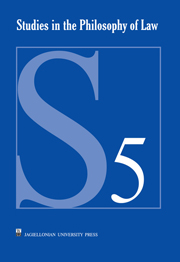Book contents
- Frontmatter
- Contents
- Preface
- I Legal Implications of Medical Advances
- 1 The Genomics Revolution in the Shadow of Auschwitz: Eugenics, Genism, and Genetic Genocide
- 2 Human Genetic Engineering and the Problems of Distributive Justice
- 3 Genetic Testing – Present and Future Problems
- 4 What Is So Unfair about Using Genetic Information? The Problem of Genetic Discrimination
- II Evolutionary Approach to the Normativity of Law
- III Appendix
- About the Authors
1 - The Genomics Revolution in the Shadow of Auschwitz: Eugenics, Genism, and Genetic Genocide
from I - Legal Implications of Medical Advances
Published online by Cambridge University Press: 05 September 2014
- Frontmatter
- Contents
- Preface
- I Legal Implications of Medical Advances
- 1 The Genomics Revolution in the Shadow of Auschwitz: Eugenics, Genism, and Genetic Genocide
- 2 Human Genetic Engineering and the Problems of Distributive Justice
- 3 Genetic Testing – Present and Future Problems
- 4 What Is So Unfair about Using Genetic Information? The Problem of Genetic Discrimination
- II Evolutionary Approach to the Normativity of Law
- III Appendix
- About the Authors
Summary
Genetics is often viewed as a potential medical savior not just through personalized medicine in the developed world, but also by applying genetic technology in the resource-poor world. But there is a dark side to genetics that often escapes attention. This dark side reached its depths in Auschwitz, where Foucault's biopolitics, the government's power to make live, intersected with the government's historical power to make die. The fundamental division was seen as between people and populations in which, as Giorgio Agamben has noted, a political body is transformed into a biological body whose entire life, from birth to death, must be regulated. The 1933 Nuremberg laws “on the protection of the hereditary health of the German people,” Agamben notes, “marks the caesura perfectly… citizens of Aryan descent are distinguished from those of non-Aryan descent… [deploying] a new biopolitics of racism.”
The genetic core of the new racism is explained by Germany's then leading geneticist (and mentor to Josef Mengele) Otmar Von Verschuer: “The greatest part of the German people constitutes a great community of ancestors, which is to say a solidarity of blood relations. This biological unity of people is the foundation of an ethnic body…” This genetic conception of the Volk led to labeling non-Aryans, especially Jews, as a “gangrenous appendix” in the German body that must be isolated, sterilized, imprisoned in concentration camps, and killed.
- Type
- Chapter
- Information
- Studies in the Philosophy of LawLaw and Biology, pp. 13 - 28Publisher: Jagiellonian University PressPrint publication year: 2010



